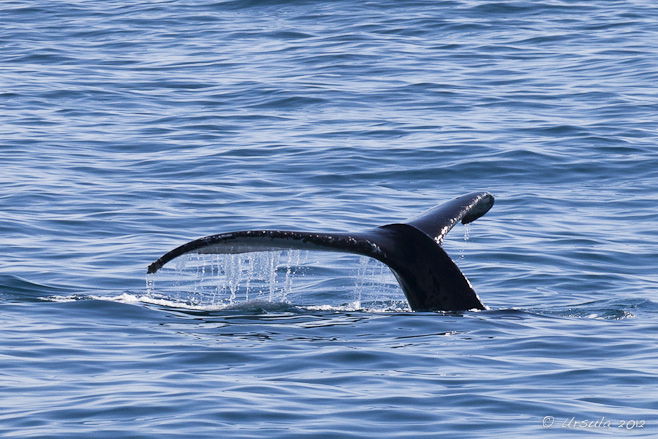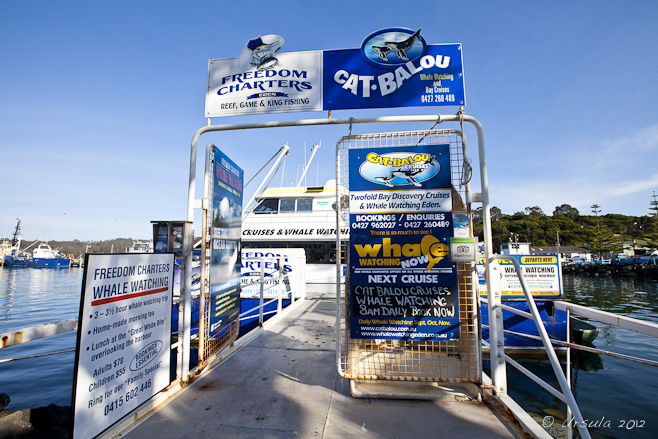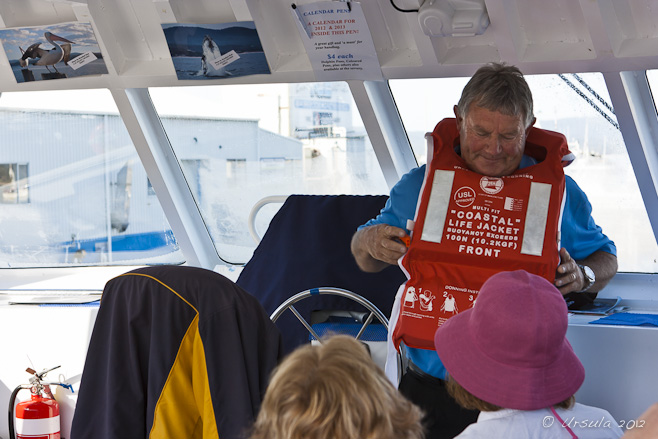
“It’s water off a whales tail.”
The humpback whales of the Australian east coast are currently making their annual migration south.
Starting from the Great Barrier Reef, where they mate and give birth in warmer waters, they begin moving towards their summer feeding grounds off Antarctica in late July. By October and November, humpbacks are commonly sighted in the sheltered waters off Eden, on NSW’s south coast.
Off course, “sighted” is a relative term. While we were on Cape Byron, in northern NSW last month, we were alerted to the presence of whales: I managed to photograph a spec of a tail on an expanse of Pacific, a splash, and a few smudges of foam on the ocean surface. So much for my first “sighting” of the season!
So as not to miss out entirely, on Wednesday we joined a whale-watching cruise with Cat Balou Cruises in our home port of Eden. We’ve sailed with them before: back in March, we enjoyed one of their Twofold Bay Discovery Cruises. The coastline around Eden is stunning, and during the migration season, Cat Balou guarantee whale sightings, so a morning on the water is a pretty safe bet.

All aboard! Entry point for Eden’s whale watching cruises.
Of course, like other whale watching operations, Cat Balou can’t guarantee that the whales will actually do anything. We were lucky enough to see our first wild humpback whales back in July, in the Pacific Northwest off the coast of Vancouver Island – and they were almost indistinguishable from floating logs!
So, we bundled up warmly and crossed our fingers.

“In the unlikely event…” Owner-operator Gordon demonstrates the lifejackets before we set off.

We weren’t on the water long before we met the strange sight of Australian fur seals (arctocephalus pusillus) “rafting” – floating with their flippers in the air.

Common dolphins (delphinus delphis) raced along side the catamaran as we head off in search of whales.

Smaller and daintier than the better-known smiling bottlenose dolphins, the common dolphins were a delight to watch.

Looking a bit like colourful fried eggs, jellyfish float past us.
As we found our first humpbacks, I was reminded of the well-known Indian story of the blind men and the elephant. You know the one: six blind men try to describe an elephant after feeling only one part: one says the elephant is like a pillar after feeling only a leg; one says it is like a rope or a paintbrush after touching the tail; one says it is like a fan after touching an ear; one says the elephant is like a wall because he felt the body; etc.
I could not get a whole humpback in my mind’s eye: the whales were indeed out in our waters, but we were seeing only the small dorsal fin, or a huge tail, or a broad, barnacled back, or long pectoral fin – never the whole whale!

The dainty dorsal fins of a mother and baby humpback whale just two kilometres or so off Aislings Beach, Eden, NSW.

Boyd’s Tower, Red Point, NSW.

A Humpback dorsal fin and tail fluke south of Red Point.

All cameras are trained on the bits of whale in the waters.

Passengers on a small fishing craft get lucky as a mother and calf pass directly in front of them.

Owner-operators Gordon and Ros keep watch for more pods from the upper cabin of Cat Balou.

It was a beautiful day on the waters, even if the whales refused to breach. Red Point, NSW.

A “footprint” on the water, created by the humpback’s powerful tail flicks as it dives.

Water splash and barnacles on the broad humpback back.

A spectacular humpback tail slap.

In a shallow cove, a large humpback with her long pectoral fins does slow rolls…

… while calves and dolphin play around.

Phosphorescence glows under a humpback fluke as it slaps the water.

Humpback head and blowholes.

A group of humpbacks heads out of the cove…

… in a tangle of massive bodies.

Black-faced cormorants rest on the water as we head home.

A great cormorant sits guard at the harbour entry.

A baby fur seal sits on the sea wall.

The boat is ship-shape and docked ~

~ and the upper wheelhouse is empty.
There is something magic about whales. The deep roaring rumble they made as they “called” to each other was amazing and it was a joy to watch the massive animals in what can only be described as play.
 I admit: I was disappointed that none of them breached in the leaps that humpbacks are famous for – especially when the front cover of our local paper the next day featured a perfect jump photographed only the week before! Like a blind man, I still have only bits of the whole.
I admit: I was disappointed that none of them breached in the leaps that humpbacks are famous for – especially when the front cover of our local paper the next day featured a perfect jump photographed only the week before! Like a blind man, I still have only bits of the whole.
But, I feel lucky for that privilege. And, maybe next time, we’ll get even luckier!
‘Till then, safe sailing.
Pictures: 31October2012
































.png)


Amazing creatures
Nice photos Ursula, looks like you were lucky enough to get reasonably close.
Thanks, Kevin and Gabe. Nice of you to stop bye! 🙂
Fabulous, its been some years since we did the same cruise and they are magnificent. Thanks for the share.
How was your return visit to Hervey for the whales? It is just the best place to really experience the whales up close.. And such an amazing feeling when they just roll over and look at you.. Did you have some great experiences again this time?
[…] We were extremely lucky last year: we participated in whale-watching tours twice. Once was last October, during the antipodean spring, when humpbacks make their annual migration south – past my home in Eden, NSW – to their summer feeding grounds in Antarctica (Watching Water 2). […]
Hi Ursula
As a fellow traveller (6 years on the road), I really enjoyed your photos. They are the ones I wish I had taken.
I am currently putting together a Maritime Highlights map of Eden to Green Cape. See https://www.google.com/maps/d/edit?mid=1eDuVdzjgaBne2ra-6to3MFeHVbaSN7Zh&usp=sharing
I have used two of your photos from this page for the Eden Lookout Point icon. They have been credited to you and I have kept your copyright symbol. The map is not commercial. Please get back to me of you have any objections.
Best regards
Mori
Hi Mori,
Thanks for your visit to my PhotoBlog.
Your project looks fascinating! I’m happy for my photos to be included as you have outlined.
Best wishes,
Ursula